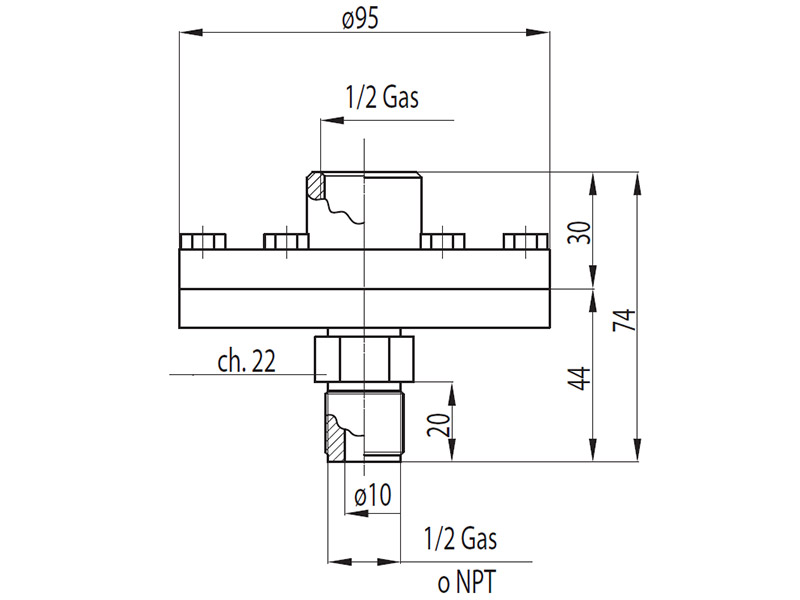- Phone: +39 0331 642232
- Email: mail@fantinelli.it
FANTINELLI Srl
Diaphragm seals - threaded
HOME | PRODUCTS | DIAPHRAGM SEALS | DIAPHRAGM SEALS THREADED | FP 337 / 437
Diaphragm seal for specific
applications FP 337 / 437

• Mounting
- direct; (identification R)
- remote by flexible capillary (identification S followed by the number indicating the capillary length in meters)
note: the remote mounting requires seal and pressure gauge set at the same level to avoid false calibration.
• Capillary material
- AISI 316L stainless steel with flexible armour of AISI 316;
- AISI 316L stainless steel with flexible armour of AISI 316 and PVC protection (option V79).
• Element (see special materials)
o diaphragm:
- AISI 316L st. st.
- AISI 316L st. st. with P.T.F.E. coating;
- special materials (Monel 400, Hastelloy C276, titanium, tantalum).
- AISI 316L st. st. 40 micron gold plating.
o bellows:
- AISI 304 stainless steel (FP 344).
note: cas indicated in the specific models, the separation chamber has a shaped upper part, that allows the diaphragm to stop without demages, in presence of over-pressures.
• Body material (see specific models)
o upper part (where scheduled):
- AISI 304 or AISI 316L stainless steel.
o pressure connection:
- AISI 316L stainless steel;
- AISI 316L stainless steel with P.T.F.E. coating;
- galvanized carbon steel (FP344);
- exotic materials (Monel 400, Hastelloy C276, titanium, tantalum).
• Pressure connection (see specific models)
- threaded;
- flanged;
- sanitary.
• Diaphragm position (see specific models)
- facing;
- back side.
• Filling fluid (see specific models)
- silicone fluid suitable for temperatures -30 ÷ +200 °C (this fluid is food compliant);
- diathermic fluid suitable for temperatures > +200 ÷ +400 °C;
- fluorinated fluid suitable for oxygen service and temperatures -30 ÷ +150 °C.
• Thermal drift
diaphragm seal can affect instrument accuracy according with the service conditions because of the pressure/temperature ratio.
Diaphragm seals
Diaphragm seal consists of an elastic element that insulates the process fluid from the sensing element, transmitting pressure through the compression of a liquid in a separation chamber.
It is necessary to adapt this device where there are particular physical and chemical characteristics incompatible with the sensing element. This way the instrument is no more subject to drawbacks caused by particularly aggressive fluids or by highly viscous, crystallizable or solidifiable process fluid.

• Mounting
- direct; (identification R)
- remote by flexible capillary (identification S followed by the number indicating the capillary length in meters)
note: the remote mounting requires seal and pressure gauge set at the same level to avoid false calibration.
• Capillary material
- AISI 316L stainless steel with flexible armour of AISI 316;
- AISI 316L stainless steel with flexible armour of AISI 316 and PVC protection (option V79).
• Element (see special materials)
o diaphragm:
- AISI 316L st. st.
- AISI 316L st. st. with P.T.F.E. coating;
- special materials (Monel 400, Hastelloy C276, titanium, tantalum).
- AISI 316L st. st. 40 micron gold plating.
o bellows:
- AISI 304 stainless steel (FP 344).
note: cas indicated in the specific models, the separation chamber has a shaped upper part, that allows the diaphragm to stop without demages, in presence of over-pressures.
• Body material (see specific models)
o upper part (where scheduled):
- AISI 304 or AISI 316L stainless steel.
o pressure connection:
- AISI 316L stainless steel;
- AISI 316L stainless steel with P.T.F.E. coating;
- galvanized carbon steel (FP344);
- exotic materials (Monel 400, Hastelloy C276, titanium, tantalum).
• Pressure connection (see specific models)
- threaded;
- flanged;
- sanitary.
• Diaphragm position (see specific models)
- facing;
- back side.
• Filling fluid (see specific models)
- silicone fluid suitable for temperatures -30 ÷ +200 °C (this fluid is food compliant);
- diathermic fluid suitable for temperatures > +200 ÷ +400 °C;
- fluorinated fluid suitable for oxygen service and temperatures -30 ÷ +150 °C.
• Thermal drift
diaphragm seal can affect instrument accuracy according with the service conditions because of the pressure/temperature ratio.
Diaphragm seals
Diaphragm seal consists of an elastic element that insulates the process fluid from the sensing element, transmitting pressure through the compression of a liquid in a separation chamber.
It is necessary to adapt this device where there are particular physical and chemical characteristics incompatible with the sensing element. This way the instrument is no more subject to drawbacks caused by particularly aggressive fluids or by highly viscous, crystallizable or solidifiable process fluid.


